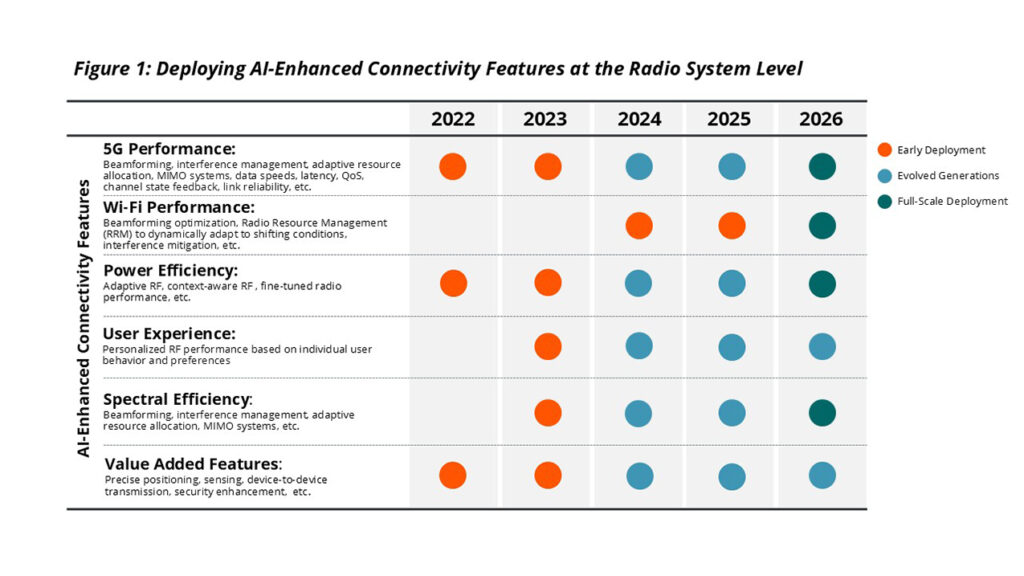The integration of Artificial Intelligence (AI) into radio systems marks a significant turning point in wireless communication technology. This trend, spearheaded by industry leaders across the entire supply chain, including mobile operators, Original Equipment Manufacturers (OEMs) and chipset suppliers, is reshaping the landscape of 5G and 5G-Wi-Fi seamless integrations. Embedding AI-assisted capabilities at the system level, particularly in Radio Frequency (RF) components, and between RF and the modem, marks a significant shift from software-based solutions to specialized accelerated AI hardware. This evolution allows the industry to tackle critical challenges, delivering substantial improvements in signal optimization, accuracy, communication efficiency, energy management, the user experience and performance. The result is enhanced connection reliability and overall performance.
By analyzing real-time data from various sensors, accelerated AI algorithms dynamically adjust signal parameters, fine-tuning transmission power, frequency bands and antenna configurations to maximize signal strength and minimize interference.
The integration of AI addresses challenges posed by an increasingly complex 5G environment, including multiple frequency operations, increased front-end components, sophisticated antenna systems, multiple data channels, new functionalities, evolving device form factors and nearby interferences. When combined with 5G technology, accelerated AI creates optimal solutions and boosts wireless innovations, tackling problematic communication challenges, while improving system throughput and spectral efficiency.
More specifically, some of the ways accelerated AI hardware enables key improvements include:
- Signal optimization
- Energy efficiency
- Beamforming and Multiple Input, Multiple Output (MIMO)
- Precise positioning
- Adaptive modulation and coding
- Interference management
- Multi-antenna management
- User-experience personalization
Implementing AI at the system level has not only been introduced at a hardware level, but also through its integration into components that have evolved over the past years and are set to continue to reach large-scale use. At its simplest, AI can manage the power consumption of RF components more efficiently. By predicting the optimal times to activate or deactivate certain RF circuits based on usage patterns and environmental conditions, AI helps extend battery life, while maintaining performance.
The major AI-enhanced connectivity features shown in Figure 1 will all be addressed through the launch of chipset support from the various suppliers. While The 3rd Generation Partnership Project (3GPP) has started standardizing the use of AI within the radio network under 5G-Advanced (Rel. 18), there have been no specifications addressing the radio system level of devices. However, it is Qualcomm that has taken the first steps through the use of AI to enhance the radio performance and experience at the device level.
Figure 1: Deploying AI-Enhanced Connectivity Features at the Radio System Level

A critical feature developing because of AI-enhanced connectivity will be that of 5G performance, with the chart showing that it will reach early deployment in 2024. Here, AI plays a critical role in beamforming and MIMO systems. AI algorithms can improve the direction and shape of RF beams, enhancing signal quality and coverage. In MIMO systems particularly, AI can manage multiple data streams to maximize throughput and reliability.
In addition, Wi-Fi performance can also be improved through the use of AI at the radio system level. The expansion of Wi-Fi into the 6 Gigahertz (GHz) band and the emergence of the Wi-Fi 7 standard are causing unprecedented technology complexity and challenges in the way that the radio is designed and implemented, which have many similarities to 5G when it was first introduced. This complexity has also been exacerbated by increasing regional variations in Wi-Fi spectrum accessibility and power level regulations. The use of AI in these contexts can help minimize interference and optimize beamforming, while using radio resource management to dynamically adapt to shifting conditions.
In terms of power efficiency, AI can be used to manage RF components more efficiently based on usage and environmental conditions, improving power efficiency. AI can also personalize RF performance for each device, based on individual user behavior and preferences, to optimize performance where it is most needed.
Another key metric benefitting from deploying AI is spectral efficiency, which has the objective to more efficiently manage an increasingly crowded spectrum. In addition, AI systems and Machine Learning (ML) models can identify patterns and mitigate interference from other devices and sources, and adjust RF parameters to minimize the impact of these disruptions. Moreover, by predicting the quality of the wireless channel, AI can select the most appropriate modulation scheme to improve data throughput and reduce error rates. Other value-added features include precise positioning, which allows for better coordination with other devices and accessories, for instance, wearables and smart home devices, with the main goal here being to improve automation and functionality.
Through the industry’s drive to adopt AI at the system level, and with a continuing upgrade of components and evolved chipsets, it is expected that most of these AI enhanced connectivity features, and their defined characteristics, will reach full-scale deployment by 2026.
With many benefits obviously apparent, several companies and organizations have been researching the use of AI in the radio system, including Qualcomm Technologies, MediaTek, Apple and Samsung, as well some OEMs, such as Xiaomi and the OpenRF consortium. Specifically, Qualcomm Technologies has been at the forefront of AI-assisted radio systems and was the first to launch AI-based solutions, with the Qualcomm AI-Enhanced Signal Boost in 2021, and the first 5G AI processor integrated in the Snapdragon X70 5G Modem-RF System in 2022. The company has since added to this with the Snapdragon X75 5G Modem-RF System, the first modem with one dedicated AI (tensor) hardware accelerator processor and, most recently, the Snapdragon X80 5G modem-RF system featuring the Qualcomm 5G AI Processor Gen 2, an integrated AI tensor accelerator in Snapdragon X80 for further 5G optimization and performance enhancements.
Designed for superior 5G and location performance, Qualcomm claims the upgrade enables up to 30% higher position accuracy with AI-enhanced Global Navigation Satellite System (GNSS) Location Gen 3 and provides innovations such as AI-based Millimeter Wave (mmWave) beam management with range extension for Customer Premises Equipment (CPE) with up to 60% faster service acquisition over legacy systems.
New iterations and more use cases will be added to the Qualcomm lineup, evolving AI-enhanced RF systems further, and putting the company in a unique position to address the market, while also taking the experience across segments. Moreover, as the market continues its shift toward 5G-Advanced and next-gen Wi-Fi, the importance of connectivity becomes ever more vital, with the addition of AI promising opportunities for higher and more precise connectivity. Applying AI to the wireless radio system, and adding innovations such as hardware-accelerated AI, still has its challenges and is very much in its infancy, but it holds undoubted benefits to and promises for the wireless arena. Entrenching AI into the modem-RF system design should, therefore, become a de facto development phase if the industry is to enable optimized user experiences, unlock innovative new use cases, provide efficiencies to the device ecosystem and make significant improvements to 5G performance.
Takeaways
For device manufacturers, the key lies in prioritizing partnerships with chipset vendors offering advanced AI-integrated radio systems. Investing in Research and Development (R&D) to leverage AI capabilities for device-specific optimizations will be crucial for staying competitive. Network operators could potentially benefit from having devices with embedded AI at the radio system level. This could allow for better utilization of network radio resources and enhanced spectral efficiency, while also unlocking new use cases and experiences for end users.
Chipset vendors need to accelerate the development of dedicated AI hardware for radio systems, focusing on use case-specific AI implementations, particularly in 5G, Wi-Fi and power management. The broader industry should work toward standardizing AI integration in radio systems to ensure interoperability, while investing in research to explore new use cases enabled by AI in wireless communications.
Looking to the future, one can expect AI to become a standard feature in radio system design for future generation networks starting with 5G-Advanced, crucial for optimizing user experiences and unlocking new use cases. A surge in AI-driven innovations, particularly in beamforming, MIMO systems and precise positioning, is on the horizon. Companies currently spearheading AI innovation in radio systems are strategically positioned to shape the implementation of AI in next-generation telecommunications standards, particularly 6G. Their cutting-edge expertise and technological breakthroughs will be instrumental in defining the architecture and capabilities of future wireless networks, potentially setting industry benchmarks and influencing global standards.
In conclusion, the integration of AI into radio systems represents a pivotal shift in wireless technology. As the industry moves toward more sophisticated 5G implementations and beyond, AI will play a crucial role in overcoming technical challenges and opening new possibilities in wireless communications and harmonizing transmission across multiple channels, including 5G, Wi-Fi and satellite communications in the future. Stakeholders across the ecosystem must adapt to this trend to remain competitive and drive innovation in the rapidly evolving wireless landscape. Those who can effectively harness the power of AI in their radio systems will likely emerge as leaders in the next generation of wireless technology.

